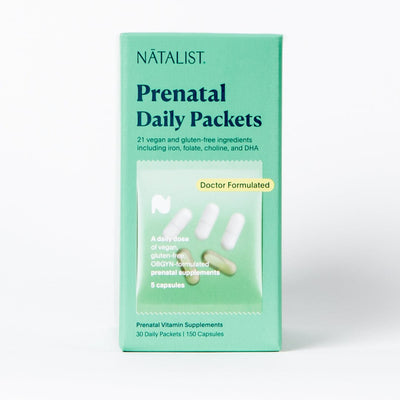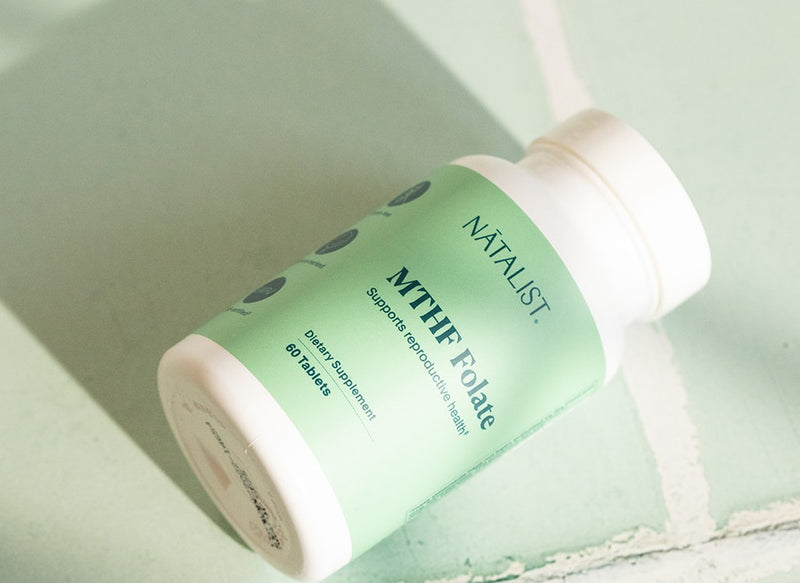











The Test Pack
Easy, at-home ovulation and pregnancy testing in one convenient bundle to get the answers you need, right when you need them.
The Test Pack gives you the best of our tests, at a great price: the Natalist Ovulation Test to find your fertile window and the early-result Natalist Pregnancy Test to accurately test for pregnancy. Get clear, accurate results every time with our bundled ovulation and pregnancy test pack.
Product Details
- Each pack comes with one month's worth of tests, so you're not wasting time and money at the drugstore month after month.
- 10 Ovulation Tests
- 4 Pregnancy Tests
- Over 99% accurate
- Easy-to-use tests with jargon-free instructions
- Satisfaction guaranteed ✨
Why We're Proud

FDA Cleared

Evidence Backed

HSA/FSA Eligible

100% Plastic Neutral

GMP Certified
Ovulation tests are clinically proven to identify your fertile window.
Our ovulation kit will help you get to know your body and its variations and identify the time when you're most likely to conceive.
- Your brain releases a surge of luteinizing hormone (LH) to tell your ovaries when it’s time to release an egg.
- The Natalist Ovulation test can identify that "LH surge" in your urine with over 99% accuracy.
- You’re most likely to get pregnant when you have sex during your LH surge.
- Our clear, jargon-free instructions will walk you through everything.


We do our homework. See the research behind The Test Pack.
The Natalist Ovulation Test identifies your fertile window by detecting your LH surge.
Ovulation is induced by a surge of luteinizing hormone (LH), a hormone produced by the anterior pituitary in the brain. This LH surge, which occurs approximately 16-48 hours before ovulation, can be detected by our easy home ovulation test. During your LH surge, an abundance of LH is excreted in urine, which the ovulation test kit will detect and display as a positive ovulation test result.
Ovulation tests are clinically proven to be accurate in predicting ovulation.
There are lots of options available to women to track ovulation: basal body temperature (BBT) charting, cervical mucus tracking, salivary ferning, and home ovulation predictor tests. Multiple studies have evaluated the clinical accuracy of the above methods and home ovulation tests that detect urinary LH, like the Natalist Ovulation Test, have consistently been shown to be accurate in predicting ovulation.
Timing is critical when you’re trying to get pregnant. Our ovulation tests find your ideal time to conceive.
Timing is everything when trying to conceive. Finding your fertile window, the days when you are most likely to conceive, is essential. It can be difficult to decode your biology to find that ideal time each month. If your cycle is irregular or of varying length, it can feel impossible as your fertile window makes itself a moving target. If that’s you, our test can be especially helpful—the clear readout of the Natalist Ovulation Test result will tell you if you are in your LH surge or not, enabling you to confidently identify your window of peak fertility.
The Natalist Ovulation Test is FDA Registered.
The sale of home ovulation tests is regulated by the Food and Drug Administration (FDA) in the United States. Ovulation tests are classified as Class I medical devices and the FDA sets regulatory standards for their manufacture and distribution, and requires that all Class I device manufacturers are registered with the FDA (FDA Registered).
I have PCOS or another fertility condition. Are ovulation tests for me?
Ovulation sticks aren’t for everyone. If you have PCOS or another diagnosed endocrine or fertility condition, please ask your doctor or provider if these tests are right for you.
The Natalist Pregnancy Test is over 99% accurate.
Our test’s accuracy was evaluated in a clinical study of over 1000+ urine samples. It found that our test is over 99% accurate in predicting pregnancy at three days before your expected period. At four days before your expected period, the test result is 97% accurate and at five days before your expected period, the test is 77% accurate. These accuracy cut-offs are regulated by the FDA and our test is equivalent to, or better than, other early-result pregnancy tests on the market.
Our pregnancy test works up to 5 days before your expected period.
You can use our test up to five days before your expected period. At five days before your expected period, the test is 77% accurate, at four days before your expected period, the test is 97% accurate, and at three days before your expected period until the day of your missed period, the test result is over 99% accurate. Early on, a pregnant woman may not be producing enough hCG for the test to detect. This is why the test is less accurate the earlier you take it. hCG can only be detected in urine after the embryo implants itself in the uterine wall, which occurs between the 7th and 10th day post-fertilization. At five days before an expected period, an embryo may have just implanted and hCG production may not have yet increased enough to meet the test’s detection threshold. Early on in pregnancy hCG levels rise rapidly, doubling every two days. The closer you are to your missed period, the more reliable your early pregnancy test results will be. At Natalist, we understand that urge to test as early as possible—we’ve been there ourselves. You get three early pregnancy tests in each box so that you can test at five days before, three days before, and on the day of your expected period, or whenever you choose.
The Natalist Pregnancy Test is FDA Cleared.
The sale of home pregnancy tests is regulated by the Food and Drug Administration (FDA) in the United States. Pregnancy tests are classified as Class II medical devices, and the FDA sets regulatory standards for their manufacture, clinical accuracy, sale, and distribution. When a Class II medical device meets these standards, it’s dubbed “cleared” after the 510k Premarket “Clearance” that it receives once it is approved for sale. Our early pregnancy test is FDA compliant and 510k Cleared.
All Natalist products and packaging are certified plastic neutral.
All Natalist products and packaging are 100% plastic neutral. For every pound of plastic we sell, we facilitate the removal of a pound of plastic pollution—giving your purchase a net-zero plastic footprint.
We do our homework. Here’s some of the research that went into making The Test Pack.
The Natalist Ovulation Test
Direito, Ana, Sébastien Bailly, Aude Mariani, and René Ecochard. 2013. “Relationships between the Luteinizing Hormone Surge and Other Characteristics of the Menstrual Cycle in Normally Ovulating Women.” Fertility and Sterility 99 (1): 279–85.
Ecochard, Rene, Olivia Duterque, Rene Leiva, Thomas Bouchard, and Pilar Vigil. 2015. “Self-Identification of the Clinical Fertile Window and the Ovulation Period.” Fertility and Sterility 103 (5): 1319–25.e3.
Eichner, Samantha F., and Erin M. Timpe. 02/2004. “Urinary-Based Ovulation and Pregnancy: Point-of-Care Testing.” The Annals of Pharmacotherapy 38 (2): 325–31.
Fehring, Richard J. 1990. “Methods Used to Self‐predict Ovulation A Comparative Study.” Journal of Obstetric, Gynecologic & Neonatal Nursing 19 (3): 233–37.
Guermandi, Ellade, Walter Vegetti, Massimiliano M. Bianchi, Anna Uglietti, Guido Ragni, and Piergiorgio Crosignani. 2001. “Reliability of Ovulation Tests in Infertile Women.” Obstetrics & Gynecology 97 (1): 92–96.
Jones, Georgina, Jill Carlton, Sarah Weddell, Sarah Johnson, and William L. Ledger. 2015. “Women’s Experiences of Ovulation Testing: A Qualitative Analysis.” Reproductive Health 12 (December): 116–116.
Leiva, Rene Antonio, Thomas Paul Bouchard, Saman Hasan Abdullah, and René Ecochard. 2017. “Urinary Luteinizing Hormone Tests: Which Concentration Threshold Best Predicts Ovulation?” Frontiers in Public Health 5 (November): 320.
Lloyd, R., and C. B. Coulam. 1989. “The Accuracy of Urinary Luteinizing Hormone Testing in Predicting Ovulation.” American Journal of Obstetrics and Gynecology 160 (6): 1370–72; discussion 1373–75.
Manders, Marlies, Luke McLindon, Brittany Schulze, Michael M. Beckmann, Jan A. M. Kremer, and Cindy Farquhar. 2015. “Timed Intercourse for Couples Trying to Conceive.” Cochrane Database of Systematic Reviews.
Su, Hsiu‐wei, Yu‐chiao Yi, Ting‐yen Wei, Ting‐chang Chang, and Chao‐min Cheng. 2017. “Detection of Ovulation, a Review of Currently Available Methods.” Bioengineering & Translational Medicine 2 (3): 238–238.
Tiplady, S., G. Jones, M. Campbell, S. Johnson, and W. Ledger. 2013. “Home Ovulation Tests and Stress in Women Trying to Conceive: A Randomized Controlled Trial.” Human Reproduction 28 (1): 138–51.
The Natalist Pregnancy Test
Braunstein, Glenn D. 2014. “The Long Gestation of the Modern Home Pregnancy Test.” Clinical Chemistry 60 (1): 18–21.
Eichner, Samantha F., and Erin M. Timpe. 02/2004. “Urinary-Based Ovulation and Pregnancy: Point-of-Care Testing.” The Annals of Pharmacotherapy 38 (2): 325–31.
Gnoth, C., and S. Johnson. 2014. “Strips of Hope: Accuracy of Home Pregnancy Tests and New Developments.” Geburtshilfe Und Frauenheilkunde 74 (7): 661–69.
Johnson, Sarah R., Sonya Godbert, Paul Perry, Pauline Parsons, Louise Roberts, Philip Buchanan, John Larsen, Todd A. Alonzo, and Michael Zinaman. 2013. “Accuracy of a Home-Based Device for Giving an Early Estimate of Pregnancy Duration Compared with Reference Methods.” Fertility and Sterility 100 (6): 1635–41.e1.
Joshi, U. M., R. Roy, A. R. Sheth, and H. P. Shah. 1981. “A Simple and Sensitive Color Test for the Detection of Human Chorionic Gonadotropin.” Obstetrics and Gynecology 57 (2): 252–54.
Robinson, Joan H. 2016. “Bringing the Pregnancy Test Home from the Hospital.” Social Studies of Science 46 (5): 649–74.
Wilcox, A. J., D. D. Baird, D. Dunson, R. McChesney, and C. R. Weinberg. 2001. “Natural Limits of Pregnancy Testing in Relation to the Expected Menstrual Period.” JAMA: The Journal of the American Medical Association 286 (14): 1759–61.














